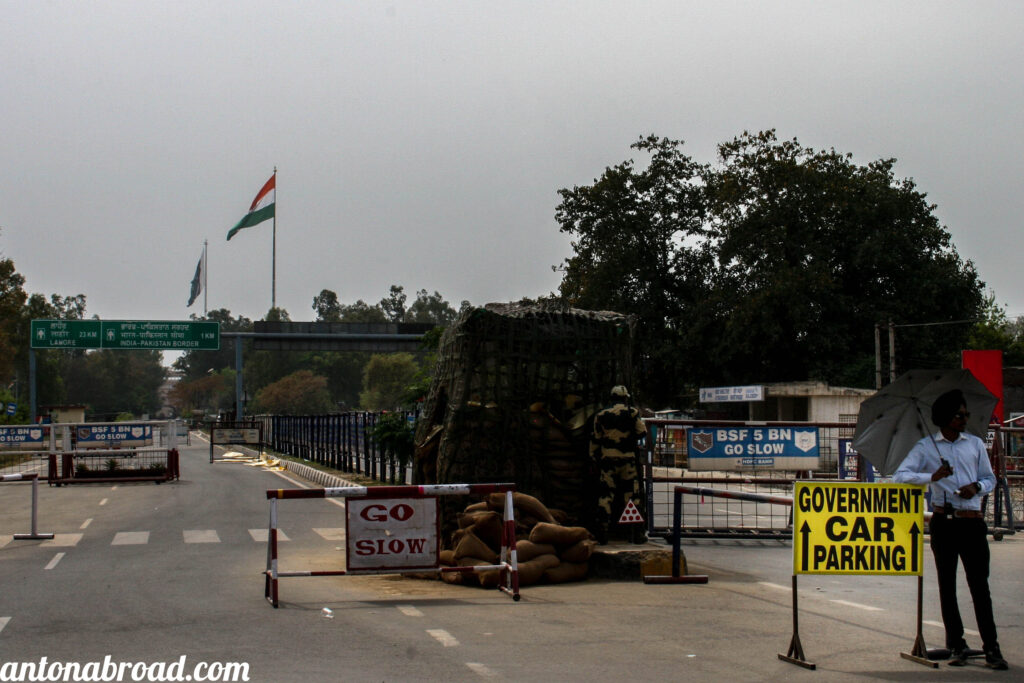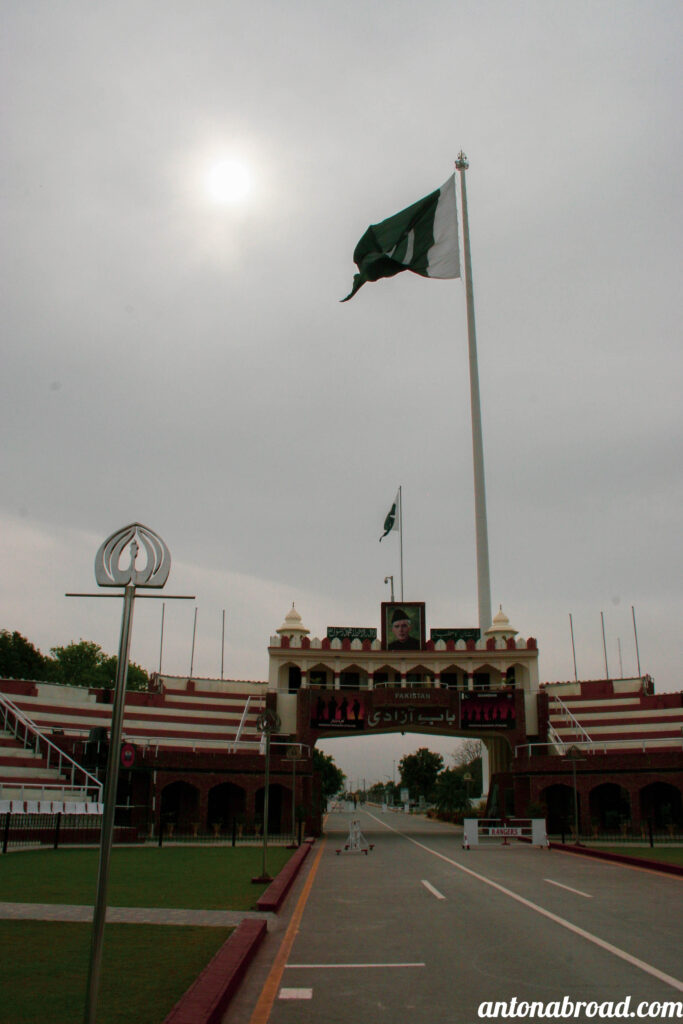India and Pakistan have an interesting tradition of celebrating their hostility. Every evening, at 17.15h (5.30 pm) both countries perform a show at the Wagah border, which is the single actively used border the countries share. This show is filled with patriotism, as well as heroism and therefore, creates a propaganda orgy on both sides to preserve the nation’s hostility.
Both countries have nuclear weapons and are in conflict since the partition of India in 1947 which accompanied the creation of two independent dominions, India (Hindustan) and Pakistan. Learn more about the India and Pakistan conflict here.
After spending three days in Amritsar, Punjab, during which I visited the beautiful Golden Temple, I start my way towards Pakistan and leave the city by bus towards Attari, a village located 5 km away from the Wagah border.
The bus drive is one hour and costs 30 Indian Rupees. From Attari I take a Rikshaw which costs again 30 Rupees and then continue my way by foot.
There are already a lot of soldiers, the Border Security forces, who ask me for my passport.
After presenting my Pakistan visa, as well as the first page of my passport, the soldiers let me into the highly secured area which separates India from its nemesis Pakistan.
Leaving India

As I enter the first building behind the checkpoint, an officer scans and unpacks my bag. I get asked multiple questions, ranging from the duration of my trip in India to the profession of my father and mother. After the interview, my pockets get emptied and my body gets checked.
After 10 minutes of opening several bags and unfolding multiple clothes, the security guard leads me to the next officer. I have to fill in a formula and my bag gets scanned again.
With the filled formula and my bag, I am walking to the immigration officer, who asks me again different questions.
The interview lasts for about 15 minutes, as this officer is more precise than the previous one and my bag gets checked for the third time.
I have to wait for a signature on my departure letter now and spend the time talking to an Indian man who is going to Pakistan for business reasons.
He warns me: “Be careful over there. Lots of terrorists.” My reaction is a bright smile, as I heard this warning multiple times from Indians before who believe in their government’s propaganda that Pakistan is the world’s terrorism hub.
After 20 times the procedure is over and I can finally leave the building. My India visa got its exit stamp and the departure letter is signed.
A bus is already waiting for those who will cross the infamous border and I get on my seat. The bus drives towards the entry gate of the arena in which the audience is already sitting. A couple of hundred Indians are sitting there and watching me, walking towards the border.
As I start walking towards Pakistan, a soldier realizes my intention and starts opening the huge gate. My passport gets checked one last time before I am allowed to leave India, cross the no man’s land and enter Pakistan.
Adrenaline rushes through my veins, as I start walking towards the huge entry gate, which separates India from Pakistan. I am the only one who is crossing at this time and I stand alone in the middle of the venue.

Inside Pakistan
“Hello! How are you? Welcome to Pakistan!”, greets me a friendly Pakistan Ranger and reaches for my passport which I am holding in my right hand.
We chat a little bit about the places that I intend to visit and then I head towards the immigration office.
The procedure on the Pakistani side takes far less time and I get my passport stamped within 5 minutes. No weird questions, no bag- or body-checks and no extra formulas.
Even though it’s still one hour until the infamous show starts, I already go to the tribune and find a comfortable seat. Music is blasting loud to drown the sounds on the Indian side out and people are coming to my seat to take selfies with me.
“Welcome to Pakistan! How are you?”, asks me a student to my right and we start having an interesting conversation in which he (Aamir) is telling me his dream that there will be peace one day between India and Pakistan.
We chat a little bit more until the music stops and the soldiers get in their positions.
“Even if the inhabitants of India and Pakistan are divided in many ways they still have two things in common, both are hospitable to foreign guests and love to take pictures with them”, is a thought that pops up in my head while thinking about my conversation with Aamir.
The show starts…
The show starts with entertainers running from one side of the arena to the other, shouting words such as: “Pakistan…”, to which the audience replies: “…Zindabad!” (Eng.: Pakistan will live forever!”). Religion is also included in this “firing up of the crowds” and the audience’s response to the next shoutout is “Allahu akbar!” (“God is the greatest”).
After the audience is in great vein, the actual show starts with soldiers walking fast towards the Indian border, swinging their legs as high as possible. Their eyes are full of determination, as if they could just knock down the huge gate which separates their home country from its enemy India.
The soldiers on the Indian, as well as on the Pakistani side, get in place directly in front of the gate and open it. Face to face, the nemesis are standing in front of each other.
Strict faces, heavy shouts and fully armed soldiers symbolize the audience: Pakistan’s/India’s military is stronger than the military on the other side. Don’t be scared, follow your leader and be ready to fight if the other side decides to attack.
The country’s flags are getting lowered while patriotic music is playing and I am amazed by the synchronic movements of the Indian and Pakistani soldiers. The Indian and the Pakistani performances are well-matched to each other, as every step on the Pakistani side is synchronic to every step on the Indian side.
After standing in front of each other and facing the enemy for a couple of minutes, the gate gets closed and the shows continue individually on each side.
I am amused by this spectacle as I would never expect that two nations who are nemesis since decades, invest so much time and effort in a ceremony just to celebrate their enmity.
Of course, the show has the propaganda function to widen the ideological gap between India and Pakistan but does every step has to be synchronically on both sides?
The ceremony leaves me with a mixed feeling of amusement and confusion, as it was too well planned and synchronic to be a ceremony that hostiles are holding to celebrate their enmity.
Getting from the Wagah Border to Lahore
“Hey Anton, how will you get back to Lahore?”, asks me Aamir, the Pakistani that I met at the beginning of the show.
I have no answer to that question and therefore take Aamir’s offer to join him and his university friends in their rented bus.
Please not that there are no public buses from the Wagah border to Lahore. I saw some taxis that are probably over-prized so I recommend figuring out a mode of transportation beforehand.
The Pakistani people are some of the friendliest and most welcoming people that I have ever met, so it shouldn’t be a problem to talk to some of them during the show and arrange a lift to Lahore.
Driving with Aamir towards Lahore, my mind is still thinking about the ceremony and the feeling of having crossed one of the most secured borders in the world.
I remember the words of the Pakistan Rangers soldier and smile.